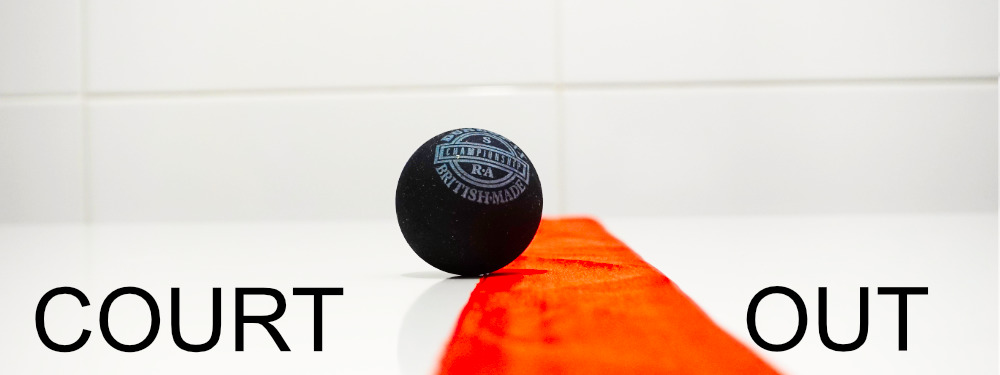04 December 2022 / 3-Min Read / Translate
The first thing I want to do is apologise for the quality of images I use below. The squash court I use to make my videos is currently closed due to being repaired and repainted, so I had to set something up in my kitchen. When I can, I’ll replace the photos and remove this apology.

Here's the view that caused all the trouble. The ball is out, right?
So for those that don’t know, Japan scored a goal against Japan in the 2022 World Cup and many people thought the ball was out of play. According to the “chips” (Yes, the balls actually have sensors inside for geolocation!) and photographic evidence, the ball was deemed “in play” and the goal allowed to stand.
I don’t follow football, and was surprised to learn that if ANY part of the ball is in virtual contact with ANY part of the line, the ball is considered “in”. Now, “virtual contact” means if the line was extended upwards and the ball would be touching that line, then it’s in. One problem was that FIFA had an image that they didn’t seem to release until the day after, that clearly showed the ball “over” the line. Here’s part of the photograph they released.

But wait! It was actually still in.
Finally something I remember from school has a useful application: Parallax Error. Just joking, plenty of things from school are useful in life.
If a ball touches a line it is out, right? Well, yeah, but where does it actually say that in the rules? Well, the first mention of touching the lines is in the serve section; 5. It says “5.7.4. the ball, unless volleyed by the receiver, bounces for the first time in the opposite quarter-court without touching any line; and”. Then a little later it says ” 5.8. A serve that does not comply with Rule 5.7 is a fault and the receiver wins the rally. Note: A serve that hits the service-line, or the short-line, or the half-court line, or any line bounding the top of the court, is a fault.“.
So any serve that TOUCHES a line is out. Thereafter it talks about balls being “above” or “below” the line.
Interestingly, it also mentions that the court out lines Not service line or lines on the floor though (duh!) be shaped “so as to deflect any ball that strikes them.”. Now this means concave (the line goes inward). I couldn’t find any photos and even if I could access the local court, it’s just tape on the wall. I have played at many clubs that have the concave line and it really make it clear when the ball is out.
Knowing if a ball actually touched the line is a LOT harder that it first seems. Unlike football, just because part of the ball covers the line, doesn’t mean it was touching it. Let’s look at some example photos I just took. Let’s say that they are of the service line on the front wall.
I have marked what is in “court” and what is out “out”. This ball is “in” because it is not touching the line.

Here is the view from the side, that obviously you couldn’t see in a real match.

I didn’t touch the ball at all and just changed position to take the photo. You can clearly see that it is not touching the line. But what about the one below?

I wish I had moved the logo to make the difference clearer – sorry.
Is this ball touching the line? Look from the side.

I admit it’s a bit hard to see, but it *is* touching the line. I should have moved the ball across a little more, but you can see that the difference between touching and not touching is very small.
Just to complicate things, those four photographs were taken with the ball just sitting on the table. What would happen if the ball were hit just like in a real game?

Here is me squashing the ball just like it would be when hit properly. Touching? Definitely.
I have just bought a camera that can record at 1000 frames per second for a fraction of a second. (It’s a Sony ZV1 for those that are interested). The resolution is not great and it outputs a file at 25 frames per second. But if it could align it correctly and get the timing right, it would probably show that a ball squashes down to half or less than its diameter, meaning that if any part of the ball crosses the line then it probably touched the line.
What that means in reality is that you just have to use common sense to judge whether a ball touched the line. It only really matters for serve because it’s generally easier to see a ball go out, partly because it’s slower and partly because of the angle that we view it at.
It’s possible I have confused things more than simplified or clarified them. Sorry about that. Remember, if a ball touches the line it’s out. If it looks like it touched the line it might have done. Any doubts, just play a let. Make sure you don’t serve new the service line to avoid these issues.
Got any funny or relevant stories about the lines, email me below.